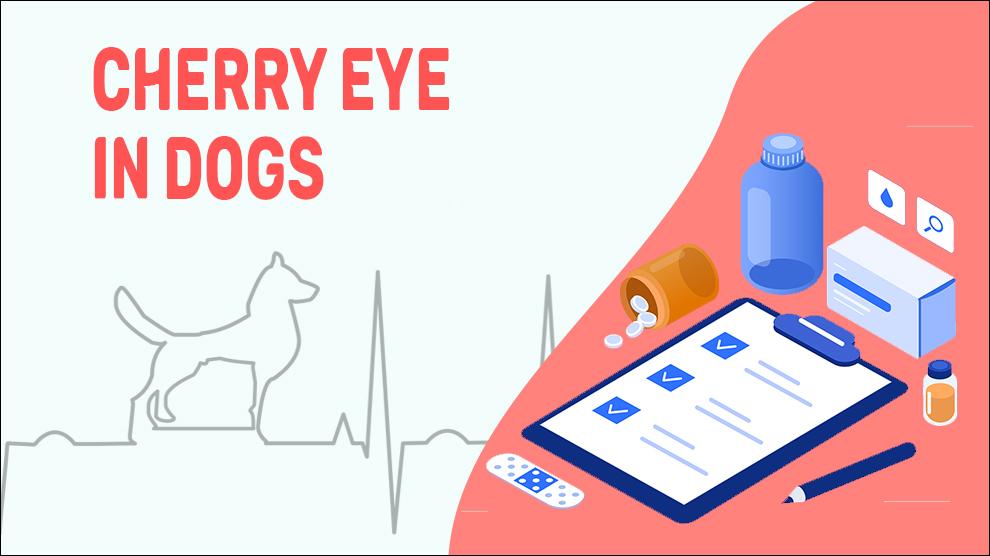What Is Cherry Eye In Dogs?
"Cherry eye" is a common term for the medical condition of prolapse or 'pop out of the third eyelid gland, also referred to as the “nictitating membrane.”
When the tear gland within this membrane becomes swollen, the membrane protrudes from the eye and looks like a fleshy pink bulge in the inner corner of the dog’s eye. The "cherry eye" may be small and appear only periodically or large enough to cover a significant portion of the cornea.
Unlike humans, many mammals (including dogs) have three eyelids for each eye. The small triangular segment of the "extra" or third eyelid in dogs is located nasoventrally inside the lower eyelid. The third eyelid functions as an additional protective layer, keep the eyes lubricated, and is also responsible for the production of tears. When this gland prolapses or protrudes, the condition is known as "cherry eye".
Cherry eye can affect one or both eyes and may not at the same time. Although the cherry eye isn’t generally painful for dogs in itself, prolapsed tear gland commonly causes dry eye and irritation. This can lead to excessive rubbing due to itching, conjunctivitis, and corneal ulcers which can be really painful.
Symptoms Of Cherry Eye In Dogs
- A smooth, oval, reddish, or pink bulge (“cherry pit”) in the inner corner of the eye.
- Rubbing or scratching the eye
- Swollen eye
- Pus-filled discharge (If any infection is present).
Treatment Options For Cherry Eye In Dogs
Check with your veterinarian or canine ophthalmologist for the best treatment option.
- Mucosal Pocket Technique: New pocket in the mucosal tissue at the back of the third eyelid is made for the tear gland. Then, the third eyelid gland repositioned, tucked into the pocket and it is sutured.
- Antibiotic medications (Metronidazole, Enrofloxacin, etc) will be prescribed to decrease the risk of infection after a surgical procedure.
- Antibacterial medications and Anti-inflammatory medications.
- Don’t forget to follow all dosage instructions on prescribed medications.
- Use an Elizabethan collar for your dog to prevent self-trauma.
Home Remedies For Cherry Eye In Dogs
Don’t miss the post-surgical eye checks once a month to check for any infection.
Until the post-operative recovery period is over, do not allow your dogs to roam outside. This will cut down the risk of trash getting into the eye and injuring the surgical site.
Control your dog from injuring their eyes (use an e-collar).
How To Prevent Cherry Eye In Dogs?
Sometimes the cherry eye appearance in the dog’s eye may decrease in severity; it seems to be improving. This is a temporary improvement and the protrusion of the eyelid will ultimately become a persistent problem.
Take your pet to the clinic as soon as possible because the ‘prolapsed third eyelid’ can easily become infected or injured.
Delay in dealing with the issue of the cherry eye will eventually lead to the risk of persistent ocular discharge, 'dry eye', and chronic conjunctivitis.
Affected Dog Breeds Of Cherry Eye
Cocker Spaniel, Bulldog, Boston Terrier, Beagle, Bloodhound, Lhasa Apso, Shih Tzu, Brachycephalic Dog Breeds, American Cocker Spaniel, English Bulldog, Pekingese
Causes And Prognosis For Cherry Eye In Dogs
- Causes:
- Hereditary
- Stretched or broken ligament
- Scarring from prior infection or trauma.
- Inflammation in the mucous membrane of the eye.
- Neoplasm
- Bony malformation
- Mortality:
Cherry eye isn't a lethal condition, but it can ultimately lead to eye problems. Discuss with your vet to figure out the underlying cause.
- Diagnosis:
- Schirmer tear test
- Fluorescein dye test
- Slit light exam
- Intraocular pressure test
- Prognosis:
Cherry eye isn't a lethal condition, but it can ultimately lead to eye problems. Discuss with your canine ophthalmologist to figure out the underlying cause.
Depending on the cause, Cherry eye can be treated with either medication to clear up the issue or surgery. The prognosis for prolapsed lacrimal gland surgery is very good.
When To See A Vet For Cherry Eye In Dogs?
Time to visit the vet clinicfor an eye examination, if you notice any of the following:
- A smooth, oval, reddish, or pink bulge (“cherry pit”) in the inner corner of the eye.
- Your dog's eyes look red and feeling of discomfort.
Food Suggestions For Cherry Eye In Dogs
- Low-carb dog food/ Whole, unprocessed foods.
- Lean meat protein.
- Vitamin C and Bioflavonoids: Brussel sprouts, spinach, broccoli, kale, pineapple, papaya, and strawberries etc.
- CoQ10 foods-organ meats, muscle meats (beef, pork), legumes, nuts, seeds, etc.
- Omega Fatty Acids- salmon, tuna, cod, halibut, trout, herring fish.
- Blueberries, Broccoli, Carrots.
- Sweet potato, Pumpkin, Tomato.
- Leafy green vegetables (lettuce, spinach, salad greens, parsley, collard greens).
- Intake of dietary nitrates- mainly from green leafy vegetables.
Conclusion
Cherry eye may result in conjunctivitis or corneal ulcers due to excessive rubbing. Dogs also have an increased likelihood of infections and other complications. The prognosis for the resolution of prolapsed lacrimal gland by one or more surgical procedures is quite good.

















